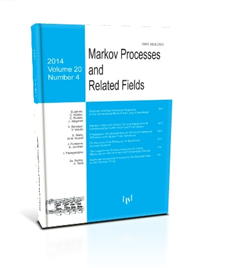Existence and Uniqueness of the Stationary Measure in the Continuous Abelian Sandpile
W. Kager, H. Liu, R. Meester
2010, v.16, Issue 1, 185-204
ABSTRACT
Let $\Lambda \subset \mathbb{Z}^d$ be finite. We study the following sandpile model on $\Lambda$. The height at any given vertex $x \in \Lambda$ is a positive real number, and additions are uniformly distributed on some interval $[a,b] \subset [0,1]$. The threshold value is $1$; when the height at a given vertex exceeds $1$, it topples, that is, its height is reduced by $1$, and the heights of all its neighbours in $\Lambda$ increase by $1/2d$. We first establish that the uniform measure $\mu$ on the so called `allowed configurations' is invariant under the dynamics. When $a < b$, we show with coupling ideas that starting from any initial configuration of heights, the process converges in distribution to $\mu$, which therefore is the unique invariant measure for the process. When $a=b$, that is, when the addition amount is non-random, and $a \notin \mathbb{Q}$, it is still the case that $\mu$ is the unique invariant probability measure, but in this case we use random ergodic theory to prove this; this proof proceeds in a very different way. Indeed, the coupling approach cannot work in this case since we also show the somewhat surprising fact that when $a=b\notin \mathbb{Q}$, the process does not converge in distribution at all starting from any initial configuration.
Keywords: continuous Abelian sandpile model,invariant measures,measure-preserving transformations,ergodic theory
COMMENTS
Please log in or register to leave a comment

